Is Your Home Ready for a New Electrical Panel?
If you’re considering a new electrical panel, here’s what you need to know:
| What is a New Electrical Panel? | When to Upgrade | Average Cost Range |
|---|---|---|
| A metal box housing circuit breakers that distributes electricity safely throughout your home | • Panel older than 25-40 years • Frequent breaker trips • Flickering lights • Adding electric appliances (EV charger, heat pump) | $2,000-$4,000 for standard upgrade $3,000-$5,000 with service upgrade Up to $600 tax credit available |
Your home’s electrical panel is the command center for all your power needs. Like an aging heart that can no longer pump enough blood, an outdated panel struggles to meet modern energy demands. Today’s homes use significantly more electricity than those built even 20 years ago—from smart devices and home offices to EV chargers and heat pumps.
When your panel can’t keep up, you’ll notice the warning signs: flickering lights when the AC kicks on, breakers that trip repeatedly, or that burning smell that makes your stomach drop. These aren’t just annoyances—they’re safety risks that shouldn’t be ignored.
Most older homes have panels rated for just 60-100 amps, while modern living typically requires 200 amps. Upgrading isn’t just about convenience; it’s about preventing electrical fires and protecting your family.
I’m Jesse Burnett, Master Electrician and founder of Dr. Electric CSRA, with experience installing over 1,200 residential and commercial electrical systems including hundreds of new electrical panel upgrades throughout the Central Savannah River Area. My team and I specialize in helping homeowners steer the panel upgrade process with safety and code compliance as our top priorities.
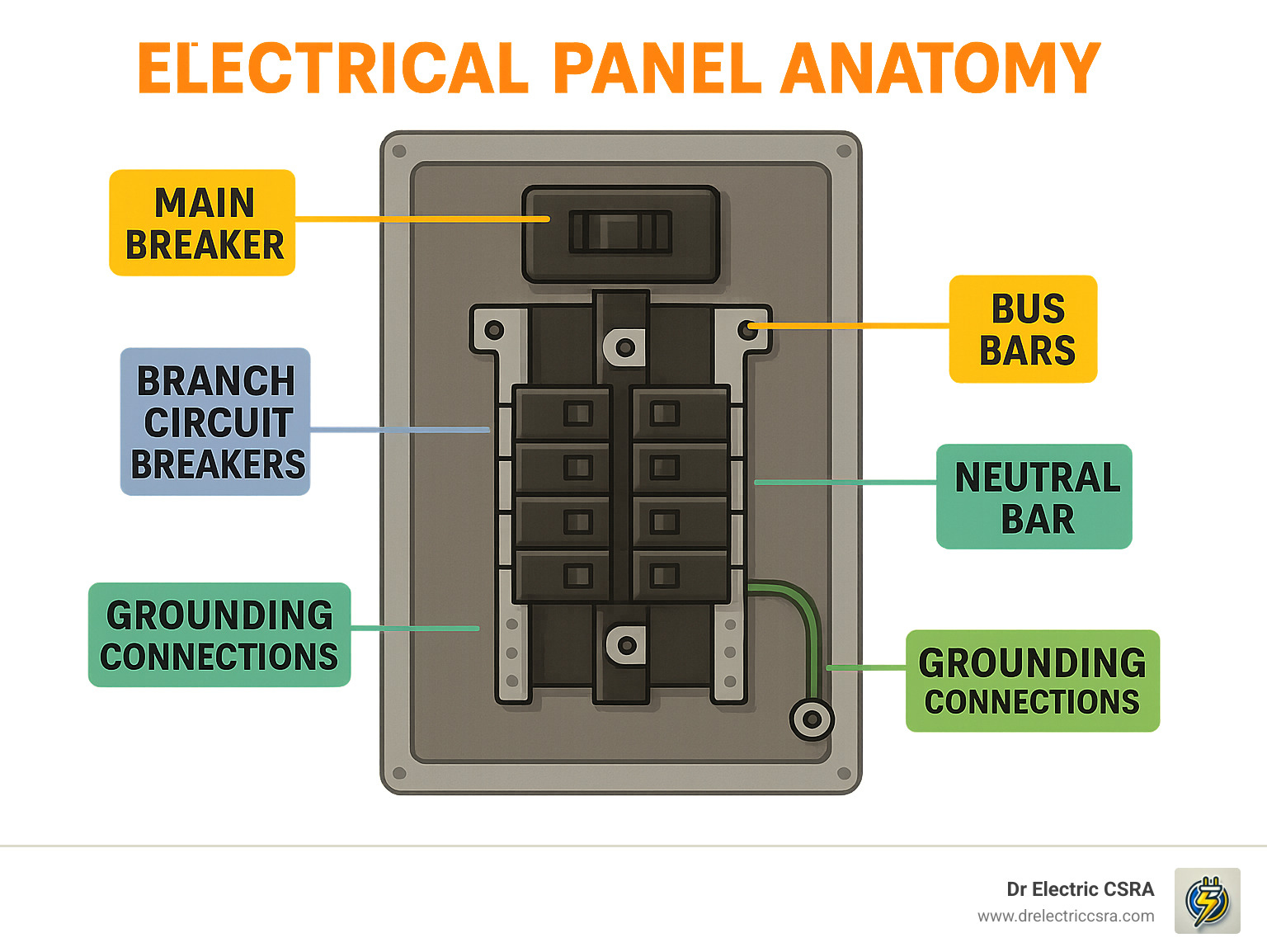
Quick new electrical panel definitions:
– cost of new electrical panel
Your New Electrical Panel Shopping Checklist
Before you dive into purchasing a new electrical panel, understand what you need. This isn’t just another home improvement project—it’s like choosing a new heart for your home’s electrical system. You want one that’s the right size, meets safety standards, and can handle both your current needs and whatever the future holds.
Quick test: what size is my panel?
Wondering about your current panel’s capacity? Here’s how to find out without calling an electrician (though we’re always happy to help!):
Look at your main breaker first—just open your panel door (keeping your hands well away from any wires) and find the largest breaker, usually sitting at the top. That number—whether it’s 60, 100, 150, or 200—tells you your panel’s amperage. Many panels also have a manufacturer’s label stating the amperage directly.
You can also make an educated guess based on your home’s age. If your house was built before the 1970s, you likely have an outdated 60-amp service. Homes from the 1970s through the 1990s typically have 100-amp service, while newer homes are usually equipped with 200-amp service.
“I see this all the time in older neighborhoods around Augusta and Evans,” our senior electrician often says. “Homes over 40 years old typically have panels that simply weren’t designed for today’s electricity demands.”
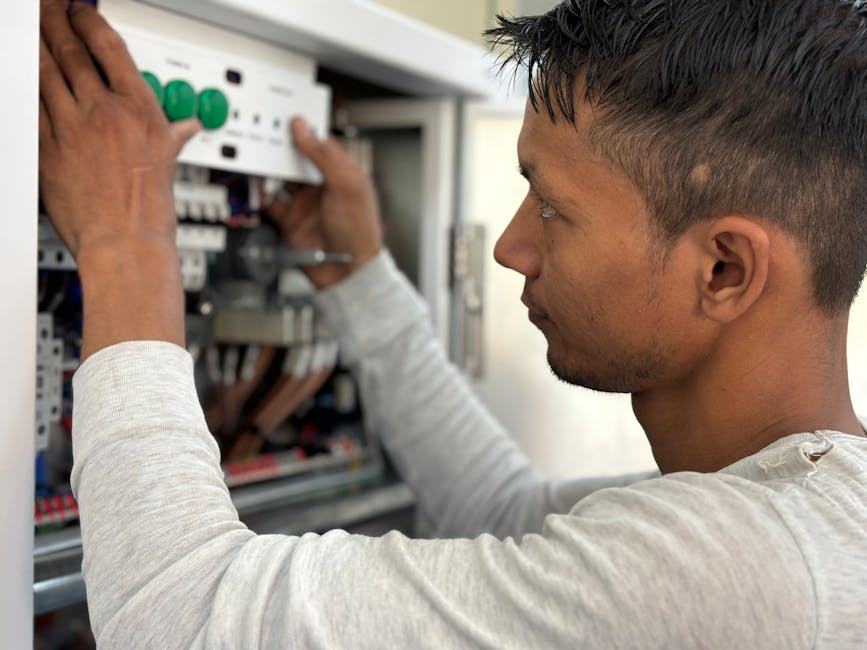
Must-have safety features before you buy
When shopping for a new electrical panel, certain safety features aren’t just nice-to-have—they’re absolute must-haves:
AFCI/GFCI protection should be non-negotiable. Arc Fault Circuit Interrupters detect dangerous electrical arcs that can cause fires, while Ground Fault Circuit Interrupters protect against shock hazards in wet areas like kitchens and bathrooms. The National Electric Code now requires these protections in many areas of your home, and for good reason.
Look for copper bus bars rather than aluminum ones. Copper simply conducts electricity better and is much less prone to overheating over time. UL listing is another critical safety feature—this certification from Underwriters Laboratories confirms your panel has been thoroughly tested for safety.
Don’t forget about the proper enclosure rating for your installation location. Indoor panels need different protection than those exposed to the elements.
“We’ve unfortunately seen the aftermath of panels that lacked these safety features,” our team lead mentions whenever discussing panel upgrades. “And trust me, it’s never worth risking your family’s safety or your property to save a few dollars.”
When calculating what size panel you need, consider your current electrical load plus any future additions. Most homes today are moving toward full electrification with heat pumps, electric water heaters, and EV chargers, making a 200-amp panel the smart choice for future-proofing. Permits are absolutely required for panel replacements, and while some homeowners consider DIY, electrical panels are one area where professional installation isn’t just convenient—it’s essential for safety and code compliance.
Want to compare options? Here’s a quick reference:
| Feature | 100 Amp Panel | 200 Amp Panel |
|---|---|---|
| Typical home size | Under 2,000 sq ft | 2,000+ sq ft |
| Electric appliances | Basic (no EV, heat pump) | Supports full electrification |
| Circuit capacity | 16-20 circuits | 30-40+ circuits |
| Future expansion | Limited | Excellent |
| Cost range | $1,800-$2,500 | $2,500-$4,000 |
Need more information about upgrading your electrical service? Check out our upgrade electrical services page.
Best New Electrical Panel Picks for 2024
After installing hundreds of panels throughout Augusta and the surrounding CSRA region, our team has some clear favorites for 2024. Think of these recommendations as coming from that trusted neighbor who happens to be an electrician – practical advice based on what actually works for local homes.
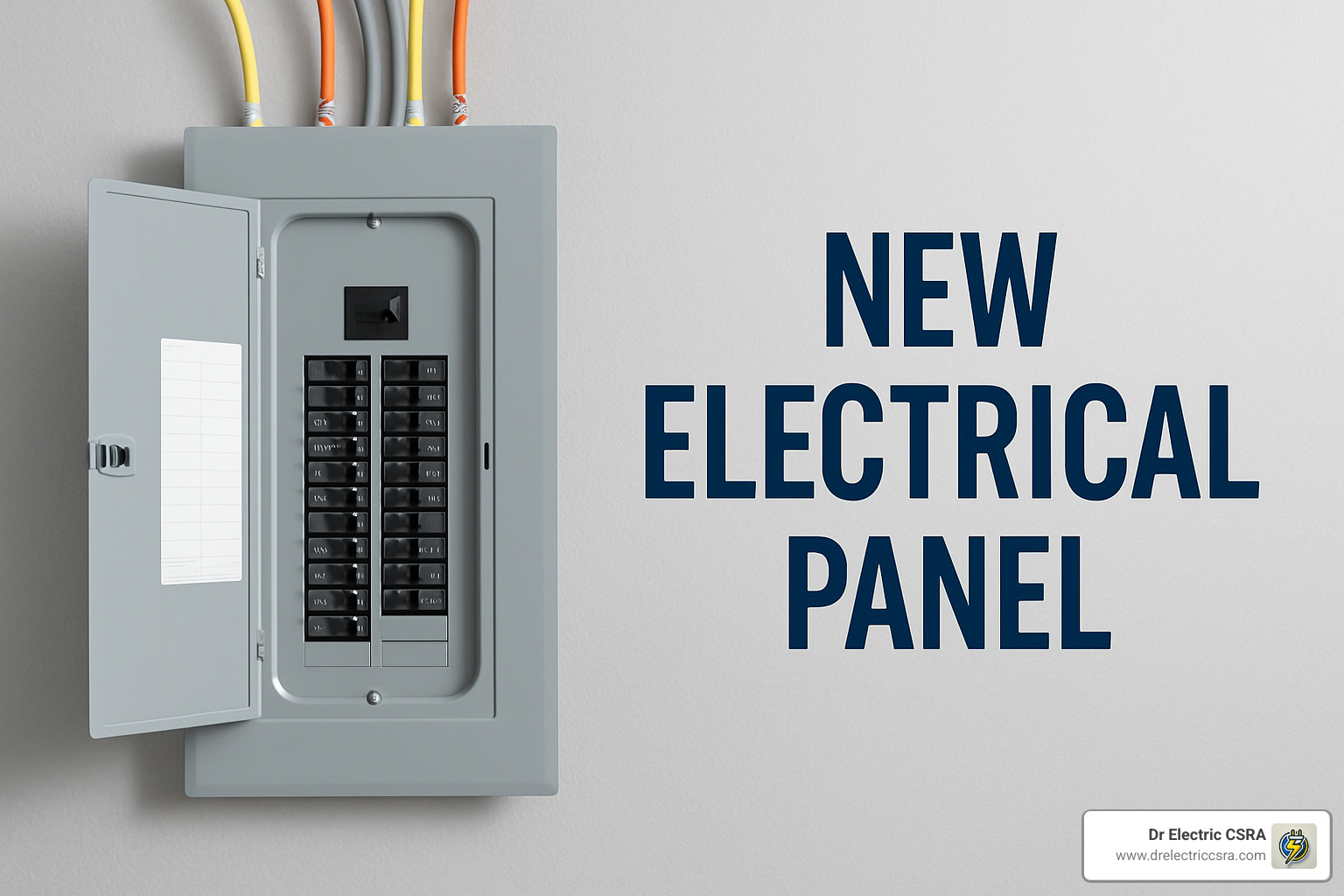
Best Budget New Electrical Panel (100 A)
Not everyone needs the biggest panel on the block. If you’ve got a cozy home with modest electrical needs, a 100-amp panel might be just right for your wallet and your needs.
A 100-amp panel makes perfect sense for smaller homes under 1,200 square feet, especially if you’re using gas for heating, cooking, and water heating. These panels typically offer 20-24 circuit spaces, which is enough for basic household needs when you’re not planning to add power-hungry additions like an EV charger.
I always tell my customers in North Augusta and Aiken that a 100-amp panel is like buying pants for a teenager – they fit now, but you might outgrow them faster than you expect. It meets the National Electrical Code minimum requirements, but doesn’t leave much room for electrical expansion.
“Last year, I installed a 100-amp panel for a retired couple in Martinez with a small ranch home,” shares our master electrician Jesse. “It was perfect for them because they had no plans to add major appliances, and it saved them about $800 compared to a larger panel.”
Future-Proof 200 A New Electrical Panel
For most homes in the Augusta area, a 200-amp panel is the sweet spot – not too small, not overkill, and ready for whatever the future brings.
When we’re installing panels in Evans or Grovetown, we typically recommend 200-amp service for any home over 1,200 square feet or any family planning to accept more electric appliances. These panels come with 30-42 circuit spaces and robust copper bus bars that can handle everything from heat pumps to electric vehicle chargers.
The beauty of a 200-amp panel is flexibility. You might not need all that capacity today, but you’ll thank yourself when you decide to add central air, convert your gas water heater to electric, or bring home that new Tesla without needing another expensive panel upgrade.
“I see it all the time,” says our lead installer, “homeowners try to save a few hundred dollars with a smaller panel, then call us back 18 months later when they can’t add that EV charger or hot tub without tripping breakers.”
Smart New Electrical Panel for Load Management
Smart panels are the new kids on the block, and they’re changing the game for energy-conscious homeowners throughout the CSRA.
These intelligent systems offer circuit-level monitoring and control through smartphone apps, letting you see exactly where your electricity is going and manage it from anywhere. For tech-savvy homeowners, especially those with solar panels or battery storage, these panels offer unprecedented control over your home’s energy use.
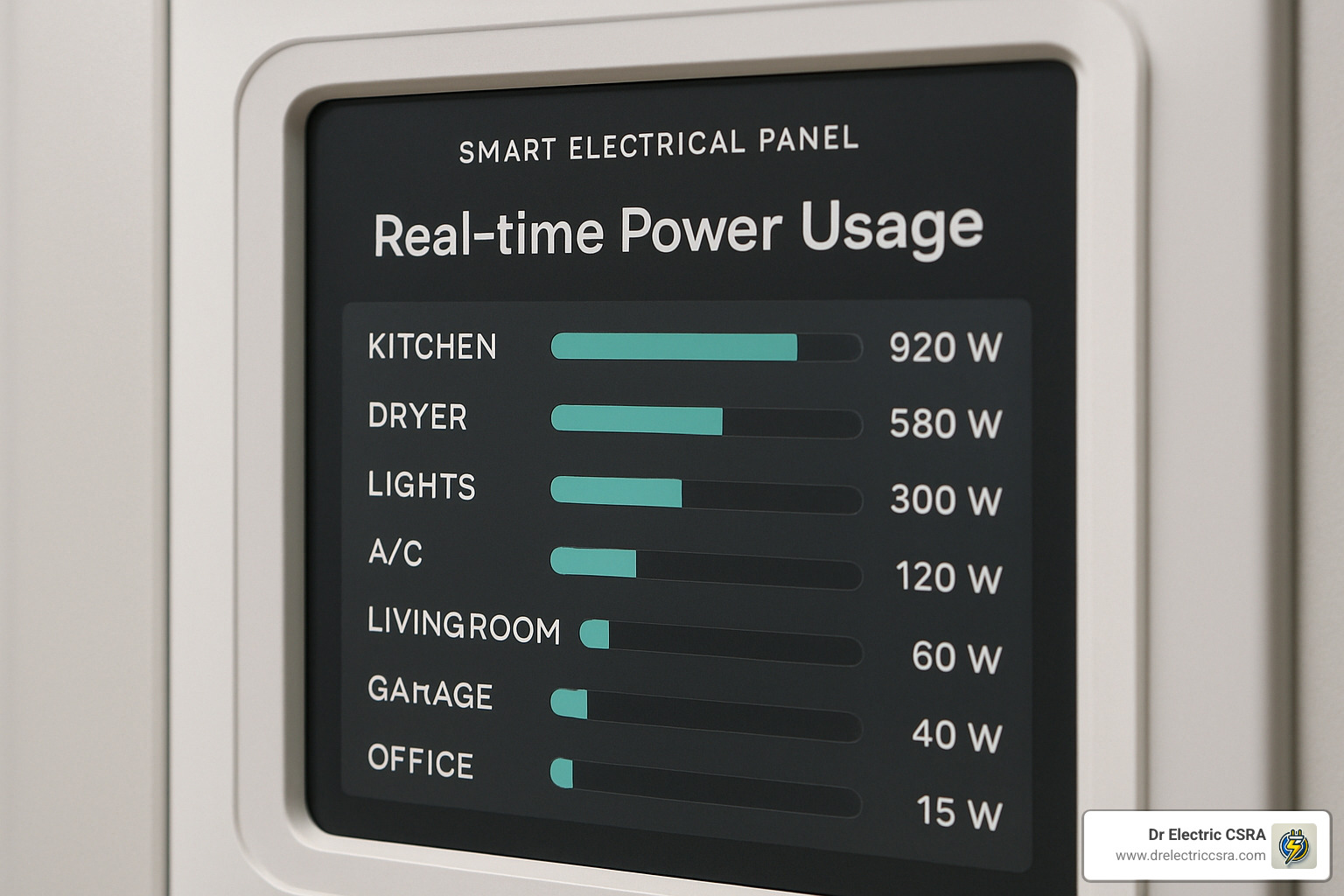
One of the coolest features is automatic load management. Say you’re charging your EV and someone starts the dryer – instead of tripping a breaker, the smart panel can temporarily reduce power to lower-priority circuits to keep everything running smoothly. This intelligent power juggling can sometimes help you avoid a costly service upgrade.
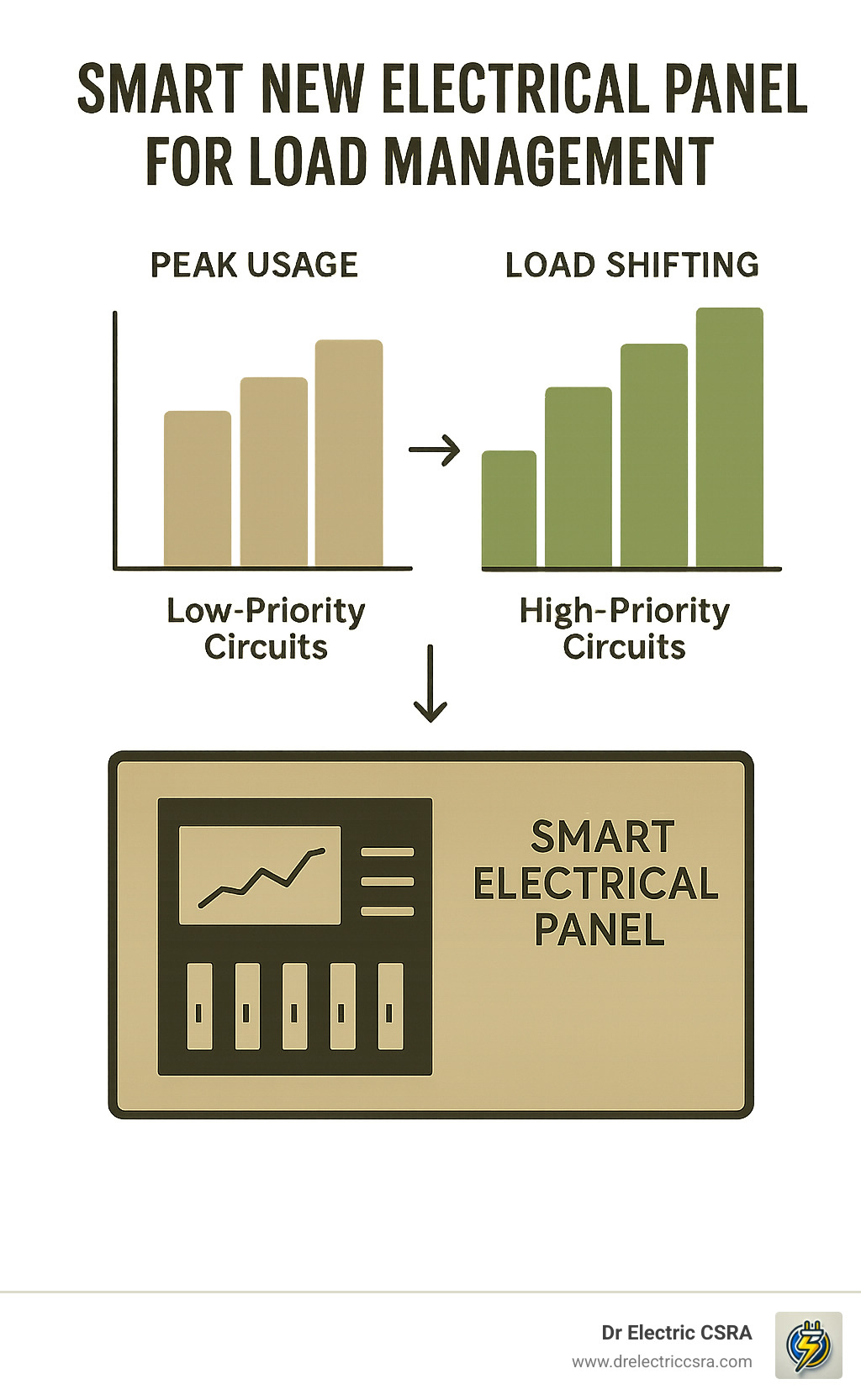
“A family in River Island installed one of these systems last summer,” our systems specialist recalls. “During a power outage, their smart panel extended their battery backup by nearly 40% by automatically prioritizing essential circuits like refrigeration and medical equipment.”
Rugged Outdoor-Rated Panel for Weather Exposed Installs
Georgia’s climate throws everything at us – humidity that feels like swimming through air, sudden downpours, and summer heat that makes asphalt soft. Any panel installed outside needs serious protection.
For detached garages, pool equipment areas, or exterior wall installations, we strongly recommend panels with a minimum NEMA 3R rating. These weatherproof enclosures with corrosion-resistant materials stand up to our challenging climate year after year.
A proper outdoor panel includes a lockable cover and built-in service disconnect for safety. This might seem like overkill until you’ve seen what happens to a standard indoor panel after a few years of Georgia weather exposure.
“I replaced three improperly rated outdoor panels after last year’s tropical storm,” says our field supervisor. “The homeowners had initially saved a few hundred dollars by using indoor-rated equipment outside, but ended up spending thousands on water damage repairs to their electrical systems.”
Incentives, Rebates & Hidden Costs
Let’s talk money—both what you might save and what might surprise you when installing a new electrical panel. After all, no one likes financial surprises after the work is done!
Available Incentives
Did you know Uncle Sam might help pay for your panel upgrade? Thanks to the Inflation Reduction Act (IRA), you can claim up to $600 back on your taxes (maxed at 30% of your project cost) when your panel upgrade supports new electric equipment like heat pumps or EV chargers.
“Just last month, a family in River Island was thrilled to learn they’d get $600 back after upgrading their panel for their new Tesla charger,” shares our office manager. “It’s like finding money in your pocket you didn’t know was there!”
Beyond federal incentives, don’t overlook local utility company rebates. Georgia Power and some local cooperatives occasionally offer special programs for electrical upgrades that improve energy efficiency. A quick phone call to your provider could save you hundreds.
For all the official details on these tax credits, visit the Home Energy Tax Credits page—it’s worth bookmarking!
Hidden Costs to Consider
While a new electrical panel itself might cost $1,000-2,000, there are several “extras” that can affect your bottom line:
The service upgrade surprise can be a big one. If you’re jumping from 100A to 200A service, your utility company might need to run a bigger line to your home. This alone can add $1,000-$3,000 to your project cost—something many homeowners don’t anticipate.
Permit fees in Augusta and surrounding communities typically run $75-$200 depending on project scope. We handle all the paperwork, but the fees are unavoidable. Think of them as your insurance that everything’s done to code.
“I always tell folks in Evans and Martinez to budget for wall repairs,” explains our lead installer. “If your panel is flush-mounted in drywall or stucco, we’ll need to open that up and patch it afterward—that’s another $200-500 depending on the finish.”
Panel relocation costs can add up quickly. Moving your panel to a safer or more convenient location might seem simple, but it can add $800-$3,000 when you factor in new wiring runs and wall repairs.
Older homes often need partial rewiring to safely connect to the new panel, especially homes built before 1980. This additional work typically adds $500-$2,000 to the project.
And if you’re eyeing those fancy smart panels (which are amazing, by the way), expect to pay a premium of $2,000-$5,000 over standard panels. They’re incredible for managing energy use, but definitely an investment.
“The panel itself is usually the cheapest part of the whole job,” our estimator often reminds customers. “It’s like buying a car—the sticker price is just the beginning.”
Want to learn more about what goes into panel upgrades? Check out this helpful guide on electrical panel upgrades.
And once your shiny new electrical panel is installed, keep it running smoothly with our Maintenance Services – because an ounce of prevention is worth a pound of cure, especially with electricity!
Frequently Asked Questions about New Electrical Panels
How long does a new electrical panel install take?
When you’re ready for a new electrical panel, timing matters—especially in Augusta’s sweltering summers when a day without AC feels like forever. Most standard installations take one full working day (about 6-8 hours) when handled by our experienced team.
“We always prioritize getting your power back on by dinnertime,” says our operations manager. “Nobody wants to be cooking by flashlight or sweating through a Georgia summer night without air conditioning.”
Your specific timeline depends on what you need:
A straightforward panel swap where we’re keeping the same location and amperage typically takes just 4-8 hours. If we’re upgrading your service capacity or relocating your panel, plan for 1-2 days. For older homes needing significant rewiring, it might stretch to 2-3 days.
Our installation process is thorough—we coordinate with your utility company for the power disconnect, remove your old panel, install the new one, connect all circuits, thoroughly test everything, coordinate inspections, and finally get your utility to reconnect power. We’ve streamlined this process for hundreds of homes across the CSRA region.
Can I add an EV charger without a new electrical panel?
“The EV charger question is probably the most common one we get these days,” notes our EV specialist. “About 60% of homes throughout Evans and Martinez need panel upgrades, while 40% can make do with their existing panels.”
You might be able to skip the panel upgrade if your current panel is already 150A or 200A, has available spaces for a new circuit, and you’re installing a lower-amperage Level 1 charger (12A-16A). Smart chargers that can limit charging during peak usage times can also help you work within your existing capacity.
On the flip side, you’ll likely need to upgrade if you’re working with an older 60A or 100A panel, have no available spaces for new circuits, or want a faster Level 2 charger (30A-50A). If your panel is already near capacity—with frequent breaker trips when multiple appliances run—that’s another sign an upgrade is needed before adding an EV charger.
For homeowners trying to avoid a panel upgrade, we often recommend smart chargers that automatically reduce charging speed when your dishwasher, dryer, or AC kicks on—a clever workaround for many households.
What signs mean I need a panel replacement now?
Some electrical warning signs can’t wait for next week’s appointment. If you notice any of these red flags, please call us immediately for an emergency inspection:
A burning smell coming from your panel, a warm or hot panel cover to the touch, sparks or smoke from the panel or outlets, crackling or buzzing sounds, discolored or charred outlets, or electric shocks when touching appliances are all serious warnings that require immediate attention.
“We had a customer in Grovetown who brushed off flickering lights for months,” our service manager remembers. “When we finally got a look at their panel, we found wires so overheated they were just days away from starting a fire. These aren’t things to postpone.”
Less urgent but still important signals include frequent breaker trips, lights that flicker when appliances turn on, fuses that need regular replacement, or simply having an older panel manufactured by Federal Pacific, Zinsco, or Pushmatic—brands known for safety issues. Any panel older than 25-40 years should be evaluated regardless of symptoms.
The bottom line? Electrical problems rarely fix themselves, and they often get worse—and more dangerous—over time. A quick inspection today could prevent an emergency tomorrow. Your family’s safety is worth it.
Conclusion
When it comes to powering your home safely and efficiently, a new electrical panel isn’t just another home improvement project—it’s an investment in your family’s safety and your home’s future.
Think of your electrical panel as the heart of your home’s electrical system. Just like your own heart, you want it strong, reliable, and capable of handling whatever demands you place on it. Whether you’re charging an electric vehicle, running a heat pump, or simply powering the everyday devices that make modern life comfortable, your panel needs to be up to the task.
Throughout Augusta and the surrounding communities, we’ve seen how the right panel transforms a home. Lights stop flickering, breakers stop tripping, and that nagging worry about electrical safety finally disappears. Plus, many homeowners are pleasantly surprised by how a panel upgrade increases their property value—buyers increasingly look for homes that are ready for today’s electrical demands.
The perfect panel for your home depends on your specific situation:
If you’re watching your budget and have modest electrical needs, a 100A panel might serve you well. For most families in today’s electrified world, a standard 200A panel provides the sweet spot of capacity and value. Tech enthusiasts embracing smart home technologies and EV charging might benefit most from a smart panel with load management capabilities. And for those unique outdoor installations, specially rated equipment keeps everything safe, even in Georgia’s challenging climate.
Don’t forget about the financial incentives! The Inflation Reduction Act offers up to $600 in tax credits when your panel upgrade supports energy-efficient improvements. That’s real money back in your pocket for doing something you needed anyway.
At Dr. Electric CSRA, we’ve been helping homeowners throughout Augusta, Evans, Grovetown, Martinez and beyond steer electrical upgrades for years. Our licensed professionals understand Georgia homes and the specific challenges they face. We’re your neighbors, and we take pride in providing solutions that keep our community safe.
Most panel upgrades take just one day—meaning minimal disruption to your life but maximum improvement to your home’s safety and functionality. Our team handles everything from utility coordination to final inspection, ensuring a smooth process from start to finish.
Ready to give your home the electrical heart it deserves? Upgrade Electrical with Dr Electric CSRA—your local, licensed experts serving Augusta & beyond. We’re just a call away, ready to help you power your home safely for years to come.


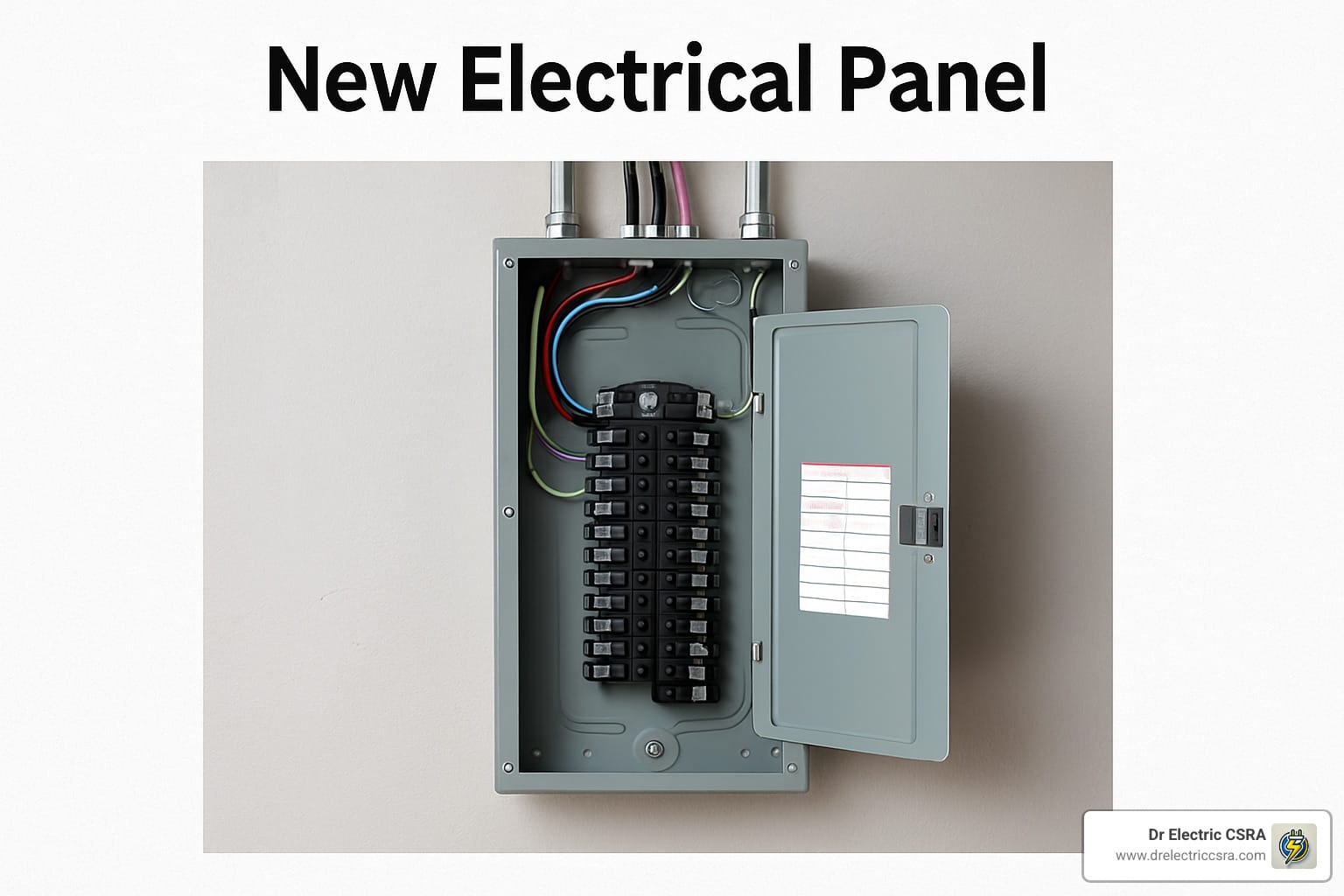



0 Comments